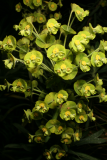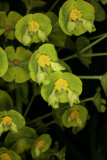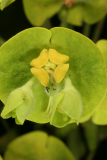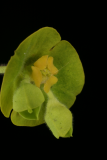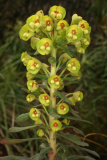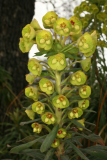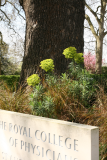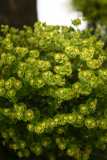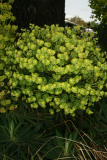Additional notes (click to expand)
Commemorative
The genus is named for Euphorbus (fl. circa 10 BC – AD 20), the Greek physician to the Berber king Juba II (c. 50 BC – AD 23) of Numidia, a country which once existed within modern Tunisia and Algeria. He was the brother of Antonio Musa (vide Musa), physician to Caesar Augustus. The king married Cleopatra Selene, the daughter of Mark Anthony and Cleopatra, and later, Glaphyra, the widow of the son of Herod the Great. The king was interested in plants and, according to Pliny the
Elder (Pliny, AD 79), gave it its name in 12 BC. In the 16th century it was known as Tithymalus, but
Linnaeus restored the name Euphorbia in 1753. One story is that Euphorbus cured King Juba from
a stomach condition with a Euphorbia. The other is that the plant was discovered by the king in
the Atlas mountains of Morocco and that, as Euphorbus was a fat man and the plant was fleshy, he thought it an apt name as ‘euphorbus’ in Greek means ‘eu = good’ and ‘phorbe = fodder’. Juba is remembered elsewhere, for he gives his name to the capital of the new country of South Sudan. Euphorbia regis-jubae, discovered on an expedition to the Canary Islands, sponsored by King Juba, also commemorates him.
Oakeley, Dr. Henry. (2012). Doctors in the Medicinal Garden. Plants named after physicians. Royal College of Physicians.
link
Medicinal
Euphorbia characias L. subsp. wulfenii Euphorbiaceae. Mediterranean spurge. Distribution: Southern Europe, North Africa.
Historical uses:
Dioscorides (Beck, 2005) advises that two obols (just over one gram) of the sap of E. characias, made into pills, caused vomiting and diarrhoea. He recognized the corrosive effect of the sap and advised coating oneself with oil or suet when extracting the sap in case it splashed onto the skin; and coating the pills with wax to avoid the sap burning the throat. He used it for toothache, applied to the tooth; as a depilatory; for treating warts, cutaneous papillomas (skin tags), cancers, gangrene, and fistulas. Recent studies have shown Euphorbia peplus sap to be effective against basal cell carcinomas and other skin cancers. The latex contains a copper containing amine oxidase, a lectin, lipase, peroxidase, and a diamine oxidase. In vitro the latex is synergistic with ketoconazole against Candida albicans (thrush). All Euphorbia have a toxic white latex, and in Europe this has been used as a folk remedy to treat warts (hence German name of Wortwurt). Gerard (1633) apparently did not believe that the sap of Euphorbia was corrosive, for he writes: ‘I tooke but one drop of it into my mouth; which neverthelesse did so inflame and swell in my throte that I hardly escaped with my life.’ It can cause skin allergies and the smoke from burning them is toxic. The genus is named for Euphorbus (fl. circa 10 BC – 20 AD), the Greek physician to the Berber King Juba II (c. 50 BC – 23 AD) of Numidia.
Oakeley, Dr. Henry F. (2013). Wellcome Library notes.
link
Nomenclature
Basionym: Euphorbia wulfenii
Other use
Euphorbia characias L. subsp. wulfenii Euphorbiaceae. Mediterranean spurge. Distribution: Southern Europe, North Africa. Dioscorides (Beck, 2005) advises that two obols (just over one gram) of the sap of E. characias, made into pills, caused vomiting and diarrhoea. He recognized the corrosive effect of the sap and advised coating oneself with oil or suet when extracting the sap in case it splashed onto the skin; and coating the pills with wax to avoid the sap burning the throat. He used it for toothache, applied to the tooth; as a depilatory; for treating warts, cutaneous papillomas (skin tags), cancers, gangrene, and fistulas. Recent studies have shown Euphorbia peplus sap to be effective against basal cell carcinomas and other skin cancers. The latex contains a copper containing amine oxidase, a lectin, lipase, peroxidase, and a diamine oxidase. In vitro the latex is synergistic with ketoconazole against Candida albicans (thrush). All Euphorbia have a toxic white latex, and in Europe this has been used as a folk remedy to treat warts (hence German name of Wortwurt). Gerard (1633) apparently did not believe that the sap of Euphorbia was corrosive, for he writes: ‘I tooke but one drop of it into my mouth; which neverthelesse did so inflame and swell in my throte that I hardly escaped with my life.’ It can cause skin allergies and the smoke from burning them is toxic. The genus is named for Euphorbus (fl. circa 10 BC – 20 AD), the Greek physician to the Berber King Juba II (c. 50 BC – 23 AD) of Numidia.
Oakeley, Dr. Henry F. (2013). Wellcome Library notes.
link
Toxicity
Toxic due to highly irritant saponins in sap (‘Latex’)
Professor Anthony Dayan, 2022
Geographical distribution
- Asia-Temperate, Western Asia, Turkey
- Europe, Southeastern Europe, Albania
- Europe, Southeastern Europe, Greece
- Europe, Southeastern Europe, Italy
- Europe, Southeastern Europe, Yugoslavia
- Europe, Southwestern Europe, France
Euphorbia characias L. subsp. wulfenii
Family: EUPHORBIACEAEGenus: Euphorbia
Species: characias L.
SubSpecies: wulfenii
Common names: Mediterranean spurge
Distribution summary: Mediterranean
Habit: Perennial
Hardiness: H5 - Hardy; cold winter
Habitat: Scrub and waste land
Garden status: Currently grown
Garden location: Plants of the World (D)
Flowering months: March, April, May
Reason for growing: Commemorative, medicinal, toxic
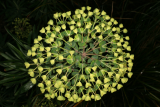
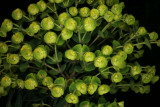
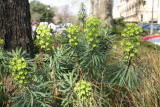
.jpg)
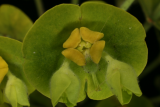
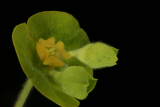
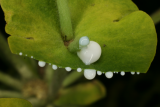
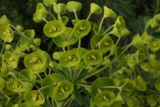
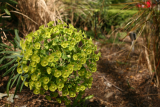
.JPG)
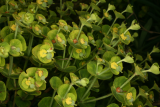


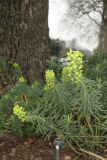
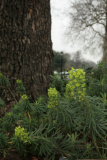
.JPG)
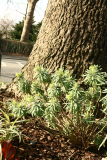
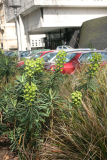
.JPG)
.JPG)
